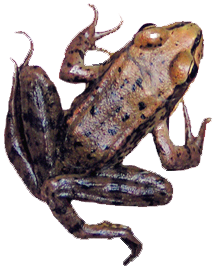The opening migration of our fourth frog season continued a pattern: it was three weeks earlier than the previous year. In 2016-17, the first movement was November 14; 2015-16 began December 7; 2014-15 - December 20; 2013-14 - January 7. This may be a simple coincidence, as the Northern red-legged frog’s forest to breeding waters migration window is from October through January, or perhaps the record rainfall we had this year in October may have primed the pump, or the small migrational pulse we had November 14 (17 frogs caught) may have been the local crowd who live toward the forest edge, or perhaps the Super Moon of that very night, the 14th, played a role. (Some believe a full moon influences the frogs.) The “local crowd” possibility may be supported by the fact that the 17 frogs were 9 males and 8 females (proximity to the wetland encouraged the females to move?), whereas usually the males far outnumber the females in the early migration, as they establish breeding territories in the wetland in preparation of the females arrival. Some have suggested we’ve simply missed earlier migrations in previous years, though this is unlikely as I walk up Harborton Drive (the first obstacle the frogs cross) nearly every day and would see signs of migration (dead frogs), or smell them (squashed frogs have a strong fishy smell). At any rate this is the sort of inside baseball stuff one thinks about when frogs have burrowed into the overgrown underbrush of one’s brain, and also, much to our chagrin, the migration season, and our evenings standing in the rain, gets three weeks longer each year.
Since the 17 frog night it’s been two weeks of tempting temps (44 to 48; borderline teasers) and rain, so we have to be ready every night for a major migration, while the frogs apparently are hanging out, cozy under ferns, or assembling on the edge of the forest to make a break into increasingly heavy rush hour traffic when we least expect it; who knows? Jane Hartline has knocked herself out once again putting together the nightly volunteer teams for each evening of the week. We have seven team leaders, each now with an assisting leader, who monitor their night’s weather and let their six or eight team members know if frog conditions look iffy, nonexistent, or perfect, meaning the team ought to stay home by the fire, be prepared to be summoned by a frantic phone call, or be out in force at dark for sure, as things will be hopping! There’s always a certain amount of guess work, as the frogs have repeatedly fooled us; not showing up when conditions seem perfect, or appearing while it’s still light out, or three weeks earlier than expected. Over the summer we’ve also been making arrangements to build small ponds on promising spots in people’s yards on the west side of the highway, to begin seeing if we can create appropriate breeding habitat so the frogs and salamanders don’t have to brave the highway.
Catching and carrying frogs across the extreme violence of modern transportation is neither good for the frogs nor a viable solution in the long term, so we need to look for more lasting answers. The simplest is ponds ranging from the size of a pool table to that of a three or four car garage. We know red-leggeds will use the ponds (see Guderyahn, Smithers, and Mims in the Science section for a full treatment), but the unanswered question is; will such ponds be viable enough to produce multiple generations of frogs, or will they be a “sink,” where the egg masses, for whatever reason, don’t consistently generate adult frogs? The Guderyahn study showed that the frogs could successfully metamorphose in small ponds, but the big question remains. So we have places and permissions to build the first two or three ponds to begin learning the answer, but first we’re pausing to consider more general study of the Harborton Creek population. The ridge this population of frogs live on, the Portland hills anticline, has been here for many millions of years. It deflected the Columbia River into its local northward course, as well as the basalt floods; a series of massive lava flows that began 17 million years ago, each of which could have covered the state of Maine in less than a week. This auspicious north facing ridge is steep and forested, so flat, sunny spots for ponds are rare, but we’ve found a few. (The ponds also need to get some sun for the pond’s food production -- tadpole’s are big eaters -- and to speed up metamorphosis.) So with luck, within the next year we’ll be in the business of building and maintaining ponds, planted out with natives, to learn definitively if they’ll help the frogs in the long run. This forested ridge runs for many miles, with many small watersheds along the way with their own populations of red-leggeds who depend on the flood plain wetlands for breeding habitat. Of course they have to brave the four lane highway that runs along the bottom of the ridge. Our biologist, Sue Beilke, believes we need to take responsibility for these populations as well, and that under and over passes of the highway must be part of the solution, projects that will cost many millions. (The Oregon Wildlife Foundation has been kind enough to be our fiscal agent. If you’d like to donate to our effort you can link to the Foundation’s web site Here .)
Dawn (from right to left): forest, Mt Hood, Willamette River, frog wetland (below frame).

